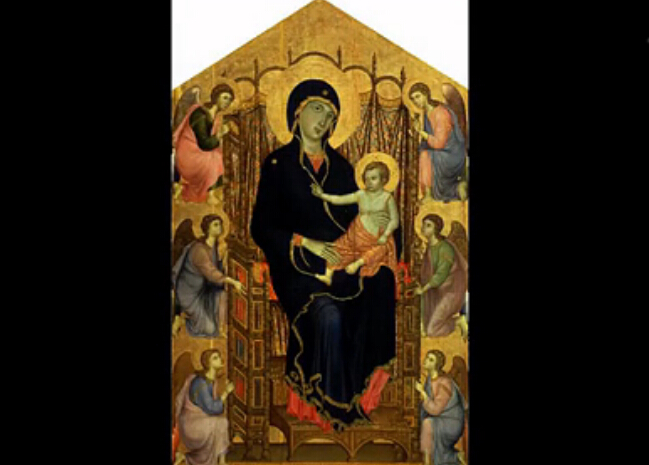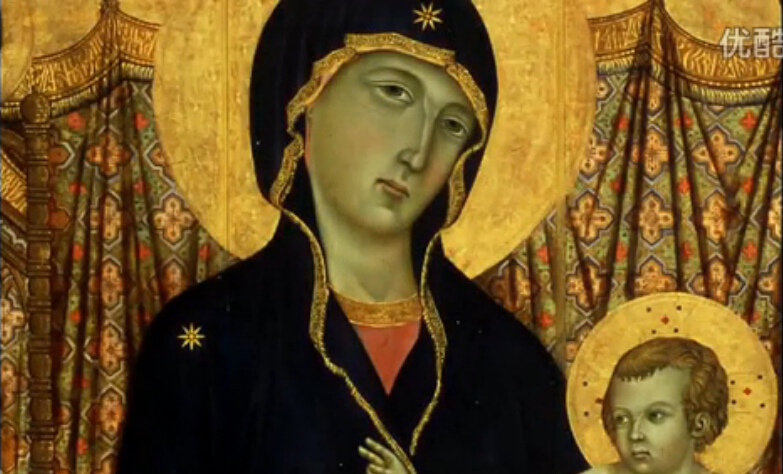(单词翻译:单击)
原味人文风情
You know, the Florentines get all the credit. And it's important to remember that there was another major city in the 1300s that was also in Tuscany that was another independent republic. And this is the Republic of Siena, with the capital city of Siena. And there was an enormously important and influential painter there whose name was Duccio. And so let's look at one of his most important paintings, The Rucellai Madonna.
你知道,佛罗伦斯画派得到所有的功劳。很重要的是要记得还有个在1300年代同样也在托斯卡尼另一个独立共和国的另一个大城市。这是锡耶那共和国,还有锡耶那首都。这里有个名为杜奇欧的极其重要、极具影响力的画家。所以来看看他最重要的画作之一:《端坐宝座的圣母与圣婴及六位天使》。

We're looking at a painting of the Madonna holding the Christ Child surrounded by 3 angels on either side and 12 feet high. It's a very large painting.
我们正看着圣母抱着圣婴两侧各环绕三个天使、有12英尺高(约3.6公尺)的画作。这是非常巨大的画作。
Yeah, it's a huge painting. In fact, the Virgin Mary herself is twice the height, if not larger, than a human being. It's an altarpiece that's meant to be seen at a great distance within a huge church.
是的,这是很巨大的画作。事实上,圣母玛利亚她自己,如果没比两倍还大的话,最少也有人类的两倍高。这是一幅刻意要在大教堂里隔着远距离观赏的祭坛装饰品。
And there's so many decorative patterns here on the throne. In the spaces in between the posts that make up the throne, we see reds and blues. And then we've got more patterning in the drapery behind the throne.
在圣座上这里有许多装饰图样。在组成圣座的柱子间的空间,我们看到红色和蓝色。接着我们在圣座后的布帘上得到更多图样。
The characteristics that you're referencing are seen by our historians to be the definition of Sienese art of this time—highly decorative, highly patterned, and with a subtlety of color that we don't often see in the Florentine.
你提到的特色被我们的历史学家视为当时锡耶那艺术的定义--高度装饰、高度以图样点缀、还有我们在佛罗伦斯画派中不常见到的色彩微妙之处。

First of all, Mary's whole body is in this lovely ultramarine blue, which was a very expensive paint. But the angels, you see purples, and greens, and pinks, and blues.
首先,圣母的全身着以这个可人的深蓝色,在当时是一种非常昂贵的颜料。但那些天使,你看到紫色、绿色、粉红色、和蓝色。
And they're subtle and prismatic in a way that we don't so much see in the flatter colors of the Florentine style.
他们很微妙又光彩夺目,在某种程度上我们看不到太多在佛罗伦斯画派风格中那些比实物更吸引人的颜色。
It's hard to see that Mary's sitting in her throne. The throne itself is so flat.
很难看出圣母正坐在她的圣座上。那圣座本身如此平坦。
It's almost the background against which she's seen. There's so much details and so much decorative patterning in the throne, especially in the cloth that drapes the throne, that its structure gets lost, because pattern, of course, does emphasize the two-dimensional.
那几乎是她被观赏时倚靠着的那背景。在那圣座上有如此多细节、如此多装饰图样,尤其是垂挂在宝座的那布料上,其结构消失了,因为当然那图样确实强调了那平面性。
You know, when I look at Sienese art, especially the Rucellai Madonna, I tend to think of an artist who is so in love with the ability to create beauty. That pattern and form tend to trump the overall representation and the emphasis on any kind of naturalism or any physicality.
你知道,当我看着锡耶那艺术,特别是《端坐宝座的圣母与圣婴及六位天使》,我很容易会想到一个如此深爱创造美感能力的艺术家。那图样和形式很容易胜过任何种类的自然主义与物质性的整体表现和重要性。
For instance, look at the Byzantine-influenced hands of Mary. Look how long those fingers are. It's almost as if the artist has gotten lost in the length of those fingers as they wrap around Christ's waist.
举例来说,看看那受到拜占庭影响的圣母之手。看看那些手指头有多长。几乎就像那艺术家迷失了那些手指的长度,当它们环抱着圣婴的腰时。
They're very beautiful, those hands. I'm thinking also about the amount of gold here. We see the disappearance of all of that gold through the 1300s into the 1400s. Here, the painting's value is largely in that ultramarine paint that was expensive and in the use of gold. And what happens during the Renaissance is that the artist himself is valued. The artist's skill becomes more valued. Not that Duccio's skill wasn't valued, but the value was also heavily in the materials that were used, that were often dictated by the patron.
它们非常美丽,那些手。我同样也在想这里黄金的份量。我们在1300年代到1400年代间看到所有那种金色消失。在这里,这画作的价值大部分在于那昂贵的深蓝颜料和黄金的用量。在文艺复兴期间发生的是艺术家本身为人所重视。艺术家的技术变得更加为人重视。不是说杜奇欧的技术没被重视,而是那份重视程度极大部分也在于使用的材料、通常由赞助者指定的材料。
Now, the ultramarine blue that you're referencing was actually made of the semi-precious stone lapis lazuli. And during the Renaissance, the only mines that were available for lapis were in Afghanistan, still a remote place for us in the 21st century. One can only imagine how exotic and rare and difficult importing from Afghanistan would have been in the 1200s.
现在,你提到的深蓝颜料事实上是由次等贵重的宝石青金石所制成的。在文艺复兴期间,唯一能取得青金石的矿山在阿富汗,对二十一世纪的我们来说仍是很遥远的地方。可想而知在1200年代从阿富汗进口会是多么奇特、罕见、和困难。
And here we have an enormous quantity of that color being used.
这里我们看到很大量的那颜色被使用。
This is, in some ways, ostentatious. In some ways, this is a painting that is broadcasting its value, its wealth, its importance. What's so interesting is this was a commission for the main altar in Santa Maria Novella in Florence, although it's by a Sienese artist. And Santa Maria Novella is the main Dominican church, that is, one of the mendicant orders, this order of begging monks that had renounced worldly possessions. So there's this interesting kind of tension.
这是,就某方面来说,很豪华的。就某方面来说,这是一幅散播其价值、其财富、其重要性的画作。如此有趣的是这是给予佛罗伦斯新圣母玛利亚教堂主祭台的委托画作,虽然它是由一个锡耶那艺术家绘制的。新圣母玛利亚教堂是最重要的道明会教堂,也就是托钵修道会之一,这个抛弃尘世财物的行乞修道士的教团。所以有这种有趣的冲突。
We mentioned that this is called the Rucellai Madonna and that's a later title. This painting was later moved away from the main altar in Santa Maria Novella and into the Rucellai Chapel, that is, the private chapel that was controlled by the Florentine family, the Rucellai.
我们提到这幅画称作《端坐宝座的圣母与圣婴及六位天使》,那是稍后的画名。这幅画后来从新圣母玛利亚教堂的主祭台被移走,放到鲁奇拉礼拜堂里,也就是由佛罗伦斯鲁奇拉家族所管理的私人小礼拜堂。
内容重点讲解
概念点拨:
杜奇欧:即杜乔·迪·博尼塞尼亚(DUCCIO di Buoninsegna,1255-1319)生于锡耶纳。从他的作品中可以看出意大利艺术的哥特式传统发展到了最高峰。与契马布埃同时代,被认为是锡耶纳画派(Sienese School)创始人,杜奇欧的作品源自于拜占庭风格,但也将人文精神融入其中,使画面看起来更显得气势磅礴。
杜乔的作品有着强烈的拜占庭元素和哥特式风格,特别是和巴列奥略王朝(拜占庭的最后一个王朝)的文化有着密切的联系。关于他的凭证可以追溯到1278年,现在已经失去了这些凭证。他现在留下的最早的一幅作品风格在明暗的运用上带有强烈的契马布埃的痕迹(Cimabue),现存于都灵的Sabauda画廊。然而在这幅杜乔年轻时所作的早期作品相比契马布埃,注入了新的元素:不属于佛罗伦萨惯例的丰富的色彩(例如粉红色的小礼服,身着酒红色长袍的圣母),画中人物如小土豆似的鼻子显得更加甜美和稚嫩,但这些都只是细节,表面上它还是属于契马布埃的样式。
其代表作是镶板画《有六位天使环绕的宝座上圣母与圣婴》(Ruccilai Madonna),原置于佛洛伦萨新圣母大教堂,现存于乌菲齐美术馆。另有在十四世纪早期颇为轰动的作品《圣母像》(Maesta)现存于锡耶纳大教堂。


